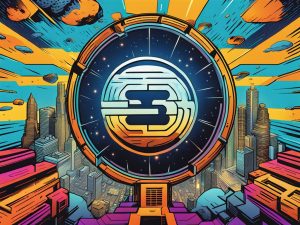Blockchain Technology for Verifying Election Data
More than 60 countries around the world will hold national and regional elections this year, making 2024 the biggest election year in history. But there are growing concerns that misinformation and disinformation driven largely by artificial intelligence (AI) will impact the elections.
An example of this recently occurred when an AI-enabled call using United States President Joe Biden’s voice phoned thousands of people across the U.S.
Findings from The World Economic Forum’s Global Risks Report 2024 further show that misinformation and disinformation are likely to be a top global risk in the next two years.
The report states that “foreign and domestic actors alike will leverage misinformation and disinformation to widen societal and political divides.”
The report also noted this risk will be even greater given that there will be a large number of elections in the near future, as more than 3 billion people are due to head to the polls in 2024 and 2025.
Blockchain Leveraged for Data Verification
While misleading information poses a major global threat, industry experts have pointed out that blockchain technology can play an important role in combating this challenge.
Paul Brody, Global Blockchain Lead for Ernst & Young (EY), told Cryptonews that like many people, he believes this year could break records for fake news.
Given this, Brody explained that EY has created a blockchain-based traceability solution called “OpsChain” that performs document notarization through a set of APIs.
“OpsChain runs on top of Ethereum public infrastructure,” Brody said. “The solution hashes and timestamps documents, placing that information on the blockchain for verification.”
The EY Ops Chain Public Edition prototype will allow companies to securely transact on a shared #publicblockchain. Find out how this new application will empower #blockchain adoption. pic.twitter.com/D4s7Qi6mO0
— EY (@EYnews) October 31, 2018
Brody shared that OpsChain is currently being leveraged by ANSA, an Italian news agency that generates over 1 million articles a year. According to an EY blog post, when an editor publishes a news story on ANSA, it’s fed into the OpsChain system with an ID and publication details. All of this information is stored as an immutable block on Ethereum.
When a story is published online, it includes an “ANSACheck” sticker, which allows readers to see who has written the article and if it has been republished.
“Readers can take the full text from an article on ANSA and verify that it’s original,” said Brody.
This is important, as Brody added that this same process can be applied to election data.
“When putting data into a public ecosystem you want it to be verifiably independent from other parties. EY’s goal is to make this easy to do by using APIs,” he said. “This allows any entity to create timestamps for data on the Ethereum blockchain. All transactions are confirmed within 15 seconds of execution.”
Cryptography’s Role for Verifying Data
David Sneider, Co-Founder of Lit Protocol, told Cryptonews that cryptographic signatures can also be used to verify data.
Sneider explained that Lit Protocol, a distributed key management network, does this by leveraging “multi-party computation (MPC) threshold secret schemes” to cryptographically sign documents and other items.
“‘Multi-party computation (MPC) threshold secret schemes’ essentially means taking key material and splitting it into different parts so that no centralized custodian has access,” said Sneider. “In the case of Lit Protocol, 20 out of 30 node operators can generate authorization to use the underlying key to sign something for data verification.”
Sneider explained that Lit Protocol’s partners that use the technology are known as “issuers,” as they have access to the decentralized key. These issuers can then create verifiable credentials, or proof, that data is accurate.
“One of our ecosystem partners is using Lit Protocol to cryptographically say that a cryptocurrency address is associated with a particular Twitter account,” Sneider remarked.
In addition, Stanford University’s Starling Lab for Data Integrity applies Lit Protocol to journalism for data verification and privacy.
“Journalists in censor-prone areas can privately and anonymously publish media content in places where the Internet is restricted,” said Sneider.
While this solution is not being applied to election data, Sneider pointed out that it can be used to ensure that publications or videos originated from election candidates or government officials.
Interestingly, the White House Special Advisor for AI, Ben Buchanan, recently stated that U.S. government officials are exploring cryptographic verification methods to combat deep fakes.
Moreover, Sneider mentioned that blockchain can be applied to cryptographic signing to serve as a timestamp as to when data was actually verified.
“A blockchain is a global clock that lets us create a timestamp and proof when certain content, for example, was published,” he said.
Digital Fingerprinting for Data Verification
While blockchain and cryptography offer immutable verification of data, other emerging technologies are also stepping in to combat misinformation. Digital fingerprinting has arisen as one such solution that can be combined with blockchain tech, providing a way to distinctly identify and authenticate content. As elections approach, these methods could prove pivotal


 By
By
 By
By

 By
By
 By
By